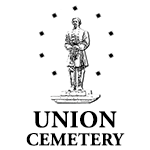
In 1855 four leading citizens of Little Compton, not satisfied with the care given to the graves in the town-owned Old Burying Ground, met in the Congregational Church to organize the Union Cemetery. The four original proprietors were John Church, Isaac Richmond, Jonathan Brownell, and Benjamin Seabury. Today, their legacy of attentive care continues, as one of the current Trustees is the great-grandson, and two are great-great grandsons of the original proprietors.
The cemetery was chartered as a non-profit corporation and laid out in the popular Garden or Rural cemetery style. At the time of the cemetery’s establishment, urban graveyards had become crowded and unsanitary, and the rise of Romanticism had brought about a changing attitude toward death. The new, park-like cemeteries were places for the living as well as the dead, embracing landscaping, paths and sculpture. The first such cemetery in the United States was Mount Auburn Cemetery in Cambridge, Massachusetts, founded in 1831. In fact, the 19th century garden cemeteries became America’s first public parks.
The original plots sold well and the trustees used the funds to install decorative curbing, fences and plantings. Families were responsible for the care of their plots. When maintenance became a problem, requests for funds were made to establish a Perpetual Care Fund. Purchase of a plot now includes perpetual care.
In 1952, land to the south was purchased to expand the cemetery. Carlton Brownell, great-grandson of Jonathan Brownell, local historian and long-time Executive Director of the Little Compton Historical Society, designed the addition with the same park-like goals as the historic cemetery. He would go on to personally manage the cemetery for many years.
Henry Tillinghast Sisson Monument

This monument is unique in that it is one of just a few civil war statues in Rhode Island that features a specific individual. It was commissioned just a few years after Henry Sisson’s death to honor his service in the Civil war. While in North Carolina, Sisson and his regiment saved troops from Massachusetts who were surrounded by the Confederate army in 1863.
After the war, Sisson became the Mill Superintendent for A.& W. Sprague Manufacturing Company, at the time, the largest calico printing textile mill in the world. He continued to serve the public as Lieutenant Governor of Rhode Island for three terms. The Sisson monument is listed in the National Register as part of the Little Compton Historic District.

